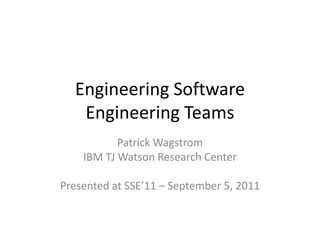Engineering Software Engineering Teams - SSE 2011
- 1. Engineering Software Engineering TeamsPatrick WagstromIBM TJ Watson Research CenterPresented at SSE’11 – September 5, 2011
- 2. What Does an Organization Do?MAGIC!Bob, can you help me here?Maybe Carl can help.Can I act on this?InfoCarlHere’s the nugget of info you need.AliceMore InfoBobSeptember 5, 20112
- 3. Hey! You Got Economics in my Software Engineering!KeynesianAustrianSeptember 5, 20113
- 4. I am not an Economist(nor do I play one on TV)KeynesianAustrianKnowledge flows downKnowledge flows upSeptember 5, 20114
- 5. What about Software Engineering?September 5, 20115
- 6. Solutions?Developer tools!BugzillaSCMMailing listsIntegrated ToolsRational Team ConcertGitHubSeptember 5, 20116
- 7. What about Software Engineering?September 5, 20117
- 8. What We DidInterviewed numerous developers, architects, managers, executives, etcPart of a larger project to build tools to support the complete software delivery processSeptember 5, 20118
- 9. General FindingsProjects had tried to work bottom up or top down, but failedOften time there was one important cogThis person was well knownNot necessarily established rankSignificant pull with external stakeholdersKnowledge of the processWe call this person an intercessorSeptember 5, 20119
- 10. Where it Gets Messy…Sometimes managers were not aware of what intercessor didSometimes developers were not aware of what intercessor didIntercessor may leave the organization and no one may knowIs there a way to empirically discover the intercessor?September 5, 201110
Editor's Notes
- #3: Talk about other models of organizations, such as garbage can, distributed constraint satisfaction, etc
- #4: These are not the only views, but they are the prominent views. These two concepts came up quite a bit with regards to government fiscal stimuli.
- #6: We can initially have a nice layout for our team, and this may work with initial constraintsAny software that exists in an enterprise will have some issues with external stakeholders
- #8: We can initially have a nice layout for our team, and this may work with initial constraintsAny software that exists in an enterprise will have some issues with external stakeholders
- #9: People worked for “global blue” corporation










